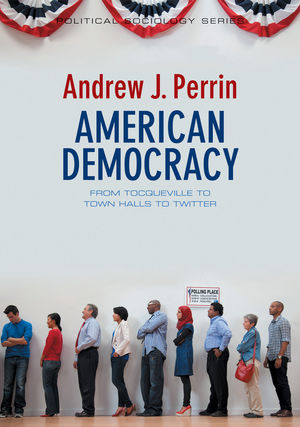American Democracy offers a compellingly-argued rethinking of how we might conceptualise America’s democratic social landscape, not least by challenging canonical approaches focused on its more formalized, institutionalized aspects. Students of democratic theory, of civil society and the public sphere, of citizenship and political participation, and those interested in American politics and political development more generally should welcome Andrew J. Perrin’s insightful analysis, writes Liliana Riga.
 American Democracy: From Tocqueville to Town Halls to Twitter. Andrew J. Perrin. Polity Press. February 2014.
American Democracy: From Tocqueville to Town Halls to Twitter. Andrew J. Perrin. Polity Press. February 2014.
Andrew Perrin’s American Democracy: From Tocqueville to Town Halls to Twitter offers a timely and important contribution to current discussions – particularly in the United States – around the tone of political discourse and the growing polarization of American civic life. To these worries, Perrin’s accessible and elegantly argued book is at once reassuring and slightly disconcerting.
His call for retrieving a Tocquevillian, culturally-anchored account of American democracy as being as applicable to today’s conditions of post-modernity and Twitter as it was to Norman Rockwell’s mid-20th century Town Meeting, together with a measured analysis of ‘a sociology of democracy as a sociology of publics’, might comfort those who view the often uncivil nature of current political discourse as something fundamentally new or intrinsically problematic. But if ‘publics are collectives, not collections’ (p. 170), and if a sociology of publics rests on the interplay between democratic culture and democratic structures, as Perrin nicely argues, worriers might nevertheless notice that even with this nuanced and expansively defined sociology of democracy – which gives as much weight to cultural and social practices as it does to the structural and institutional elements of democracy – cultural practices can nevertheless shape institutional arrangements in ways that are powerful, path-dependent, and even permanent.
American Democracy’s central argument is that democracy is first cultural and social before it is political. On both historical and sociological records, this is compelling and surely right. Democracy is learned, practiced, (re)imagined, performed, and, above all, is it is ‘a sociology of publics’ in the tradition of Habermas’s public sphere. Perrin’s argument is laid out in 6 chapters, with the first and last anchoring the theoretical argument historically and conceptually. He shows that from the beginning of the Republic, democracy has been and continues to be a deeply social and cultural phenomenon, and not just a procedural one (Chapter 1), so it is worth exploring the cultural dimensions of publics and the ways in which practices, rules, and technologies work together to form publics (Chapter 6).

Perrin develops this in three chapters as he considers practices, technologies, and institutions as entwined dimensions. Chapter 2 elaborates the key elements of democratic citizenship – individuals, civil society, and the public sphere – before turning attention, in Chapter 3, to institutions of governance, deliberation, legislation, and representation. In Chapter 2, Perrin draws a lovely analysis of the ways in which citizenship requires a democratic, collective imagination, arguing that voting itself – a seemingly private and individualized act – has an often forgotten and intrinsic sociability to it; that voting is an activity that is fundamentally social and ritualized in character (pp. 51-57, 83). Here he introduces the idea of a ‘democratic ladder’ with citizens’ preferences at the bottom, step-by-step leading up to the formation of public policy. That is, the democratic ladder begins with the simple question of whether the public actually has ideas and preferences that the government can follow, and moves up to ‘how much is government listening?’ (pp. 43-44). The ladder, in other words, carries ideas and preferences up, but media and institutions also carry ideas and information down the ladder from government back to citizens, as well as side to side from citizens to citizens (p. 45).
This simple ‘democratic ladder’ then becomes the analytical framework for a reconceptualised argument around the ways in which practices, ideas, and technologies shape and indeed instantiate publics. So in prefiguring the wider argument, in Chapter 3 Perrin writes that ‘voting is a citizenship practice based on social technologies and institutional configurations’ (p. 71, emphasis in original); the public sphere is conceived as set of practices, with voice as its minimal condition. On offer here, then, is effectively a view of American democracy as a pragmatic theory of the public sphere.
Chapters 4 and 5 then consider the roles of two of these institutions: public opinion polling and the media. In Chapter 4, on public opinion and policy responsiveness, Perrin makes the point that polling tends to obscure or ignore ‘the sociological’ that lies behind it; and that polling is not only performative, but also creative of a reality. And finally, Chapter 5 then explores the role of the media and communications, where Perrin shows how fractured, polarized media environments can damage democratic practices and fragment publics.
American Democracy offers a compellingly-argued rethinking of how we might conceptualise America’s democratic social landscape, not least by challenging canonical approaches focused on its more formalized, institutionalized aspects. Students of democratic theory, of civil society and the public sphere, of citizenship and political participation, and those interested in American politics and political development more generally should welcome Perrin’s insightful analysis. It builds on years of empirical and theoretical engagement and it does so intelligently, nimbly and accessibly.
It does, however, leave to subsequent work the need to better explore the ways in which those cultural practices, beliefs, and technologies so often neglected in accounts of democracy, and which give force and authority to electoral processes and formalized dimensions of democracy, can shape and form democratic structures and institutions in ways that are causally path-dependent or irreversible. And paying greater attention to this sociological dynamic would, actually, shift attention back to those very canonical features of democracy that have received so much attention.
This review originally appeared at the LSE Review of Books.
Please read our comments policy before commenting.
Note: This article gives the views of the authors, and not the position of USApp– American Politics and Policy, nor of the London School of Economics.
Shortened URL for this post: http://bit.ly/UwIBAM
——————————————–
Liliana Riga – University of Edinburgh
Dr. Liliana Riga is Lecturer in Sociology and Programme Director of the MSc Sociology and Global Change at the University of Edinburgh. Her interests are in comparative historical and political sociology, and in particular ethnicity, nationalism and empire. She is currently working on a project on the Americanization movement of the early 20th century in the US. Read more reviews by Liliana.






